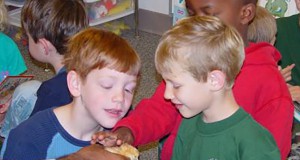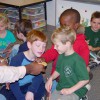
Eggcellent Adventures in Classroom Embryology is about learning through experience. In most cases, when a teacher signs up to teach chicken embryology in the classroom, the teacher sets up the incubator and the teacher and class wait for the eggs to hatch. That is the experience. But the daily plan of lessons in this guide make the chicken embryology experience an intracurricular experience. Through a series of activities, students can see firsthand how a chicken develops in an egg. Students will candle eggs to observe chick development, record data, make predictions, and conclude what they think the final outcome will be. The lessons in the guide follow Florida Sunshine State Standards and each contains an experience, instructions, background information, and reflection questions. The 31 lessons address math, language arts, and visual arts in addition to agricultural literacy and science concepts. Written by Shaina Bennett and Judy Levings and published by the 4-H Youth Development Program, October 2015.
http://edis.ifas.ufl.edu/4h368
Tag: 4-H Poultry & Embryology
Getting Started in the 4-H Embryology Project: Tips for 4-H Agents and Teachers
 Usually considered an enrichment project for classrooms, the 4-H Embryology Project can also be modified for club or individual use. In it, young people use an incubator to grow avian embryos (inside fertile eggs) through the hatching process. Students learn basic biology and life science while they eagerly look forward to hatching chicks. This 5-page fact sheet describes the necessary equipment and other resources and provides tips and suggestions to increase the hatchability of fertile avian eggs. Written by Marcus Boston, Chris Decubellis, and Judith Levings, and published by the UF Department of 4-H Youth Development, April 2015. (Photo: Marcus Boston, UF/IFAS)
Usually considered an enrichment project for classrooms, the 4-H Embryology Project can also be modified for club or individual use. In it, young people use an incubator to grow avian embryos (inside fertile eggs) through the hatching process. Students learn basic biology and life science while they eagerly look forward to hatching chicks. This 5-page fact sheet describes the necessary equipment and other resources and provides tips and suggestions to increase the hatchability of fertile avian eggs. Written by Marcus Boston, Chris Decubellis, and Judith Levings, and published by the UF Department of 4-H Youth Development, April 2015. (Photo: Marcus Boston, UF/IFAS)
http://edis.ifas.ufl.edu/4h367